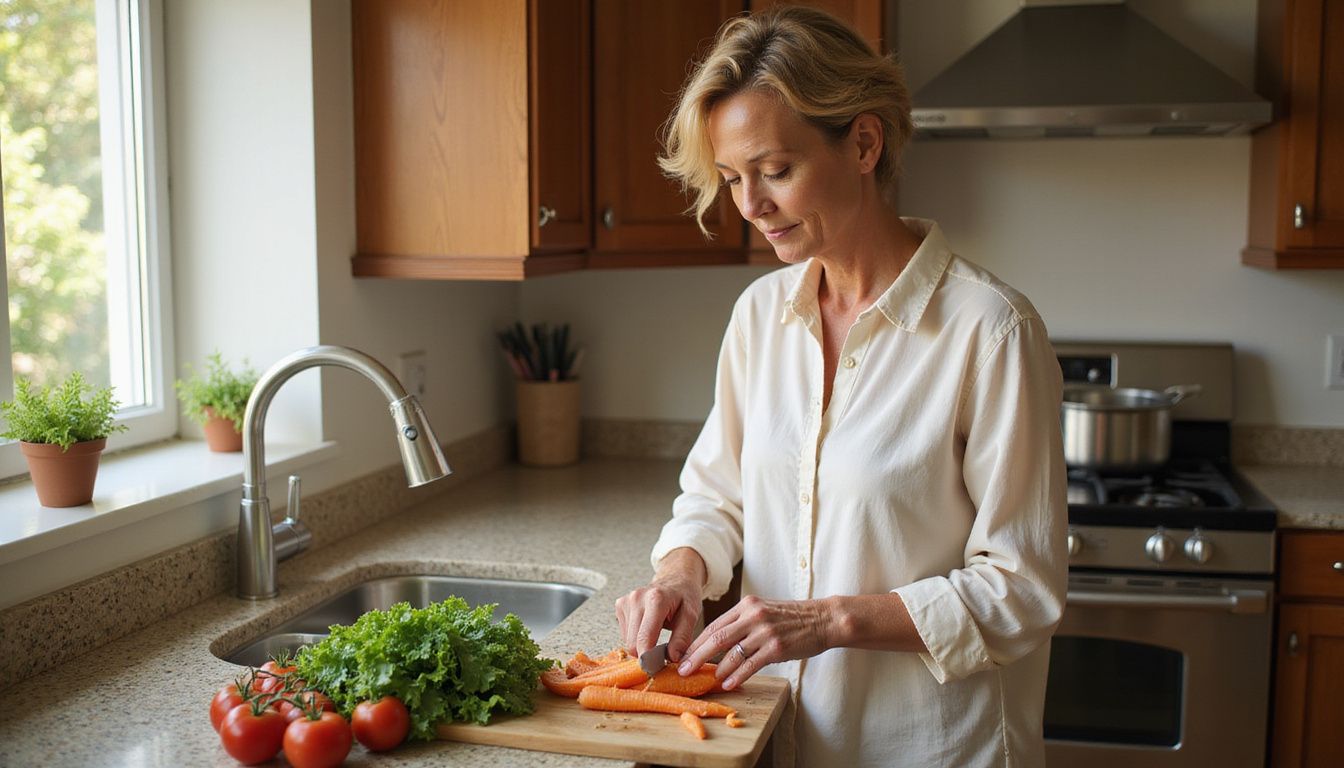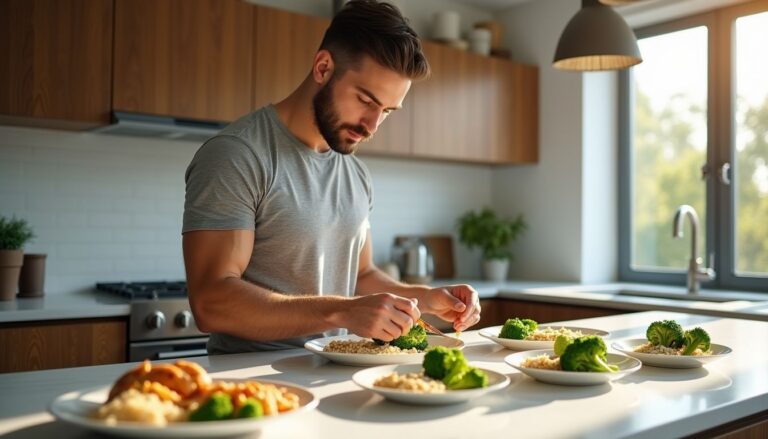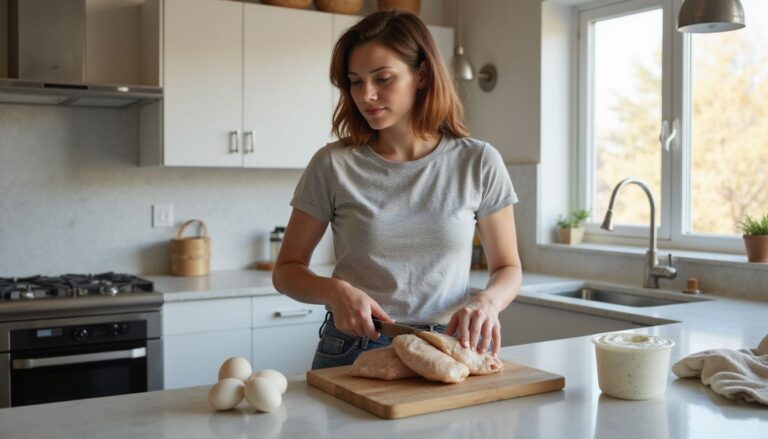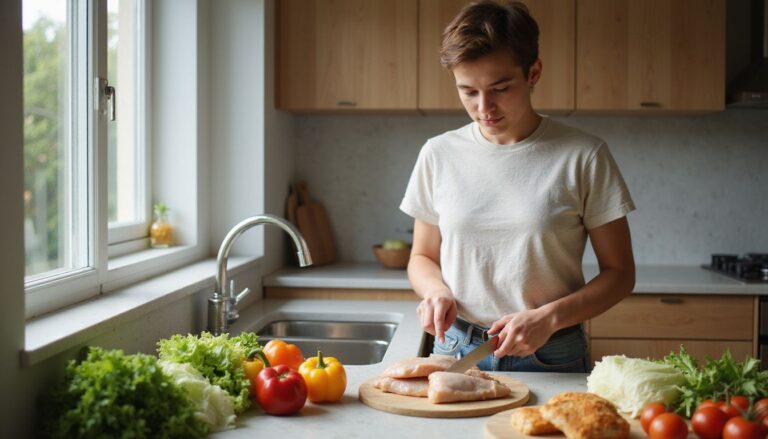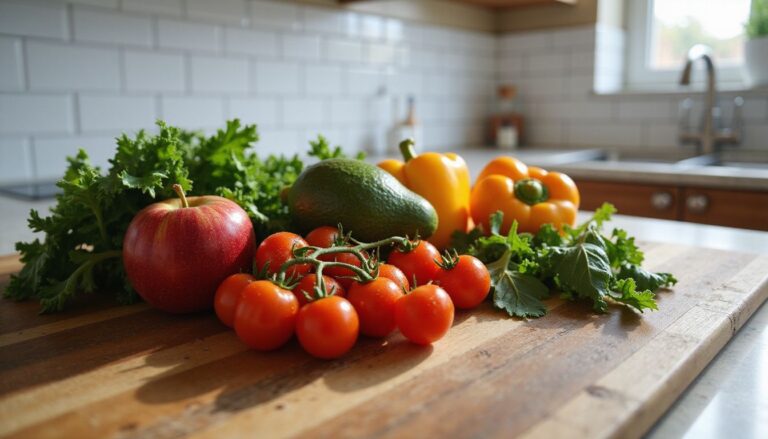Effective One Month Diet Plan To Reduce Belly Fat: Lose Weight And Target Visceral Fat
Our Nutrition Assistant AI Suite will transform your body. You will lose fat, get toned, and build muscle. Gain confidence and optimal health.
If extra belly fat has been hard to shake, this one month plan offers a clear start. Visceral fat, the deeper fat around your organs, raises the risk of heart disease and type 2 diabetes. This guide explains why it matters, then gives you a practical meal plan, foods to focus on or limit, and exercise tips so you can lose weight in a steady, healthy way.
Use the plan to trim your waistline and protect your long-term health. For medical concerns or if you take medications, check with your healthcare provider before making big changes.
Key Takeaways
- Reducing visceral belly fat lowers risk for heart disease and type 2 diabetes, as reported by the American Heart Association and JAMA.
- A daily calorie deficit of 500 to 1,000 calories helps many people lose 1 to 2 pounds per week, which aligns with CDC guidance.
- More dietary fiber from beans, whole grains, fruits, and vegetables supports fullness and helps cut visceral fat.
- Swap sugary drinks, trans fats, and refined carbs for water, lean proteins, healthy fats, and probiotic foods to improve waist size and metabolism.
- Consistent meal timing, tracking, and regular aerobic exercise promote steady belly fat loss across one month.
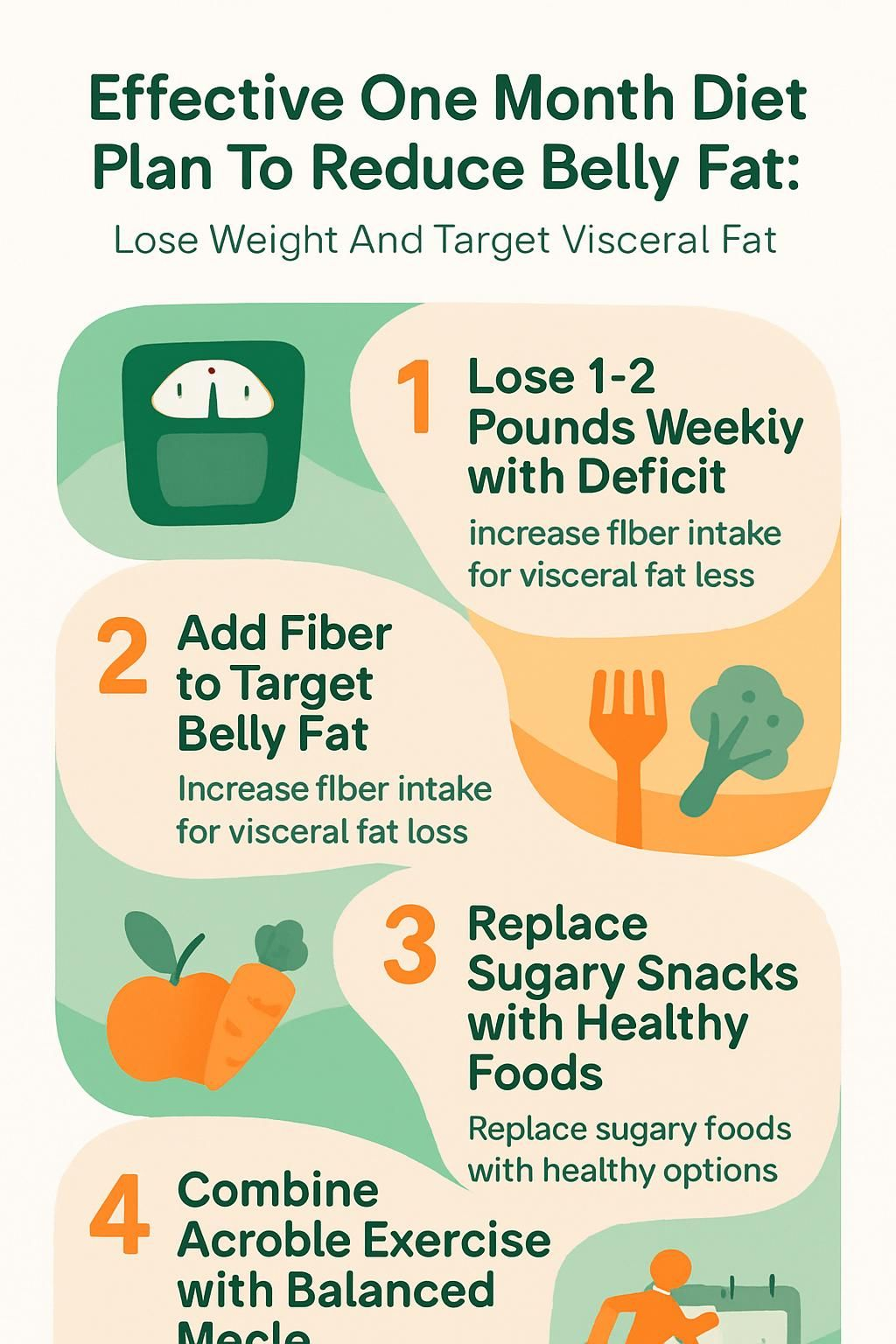
Understanding Belly Fat
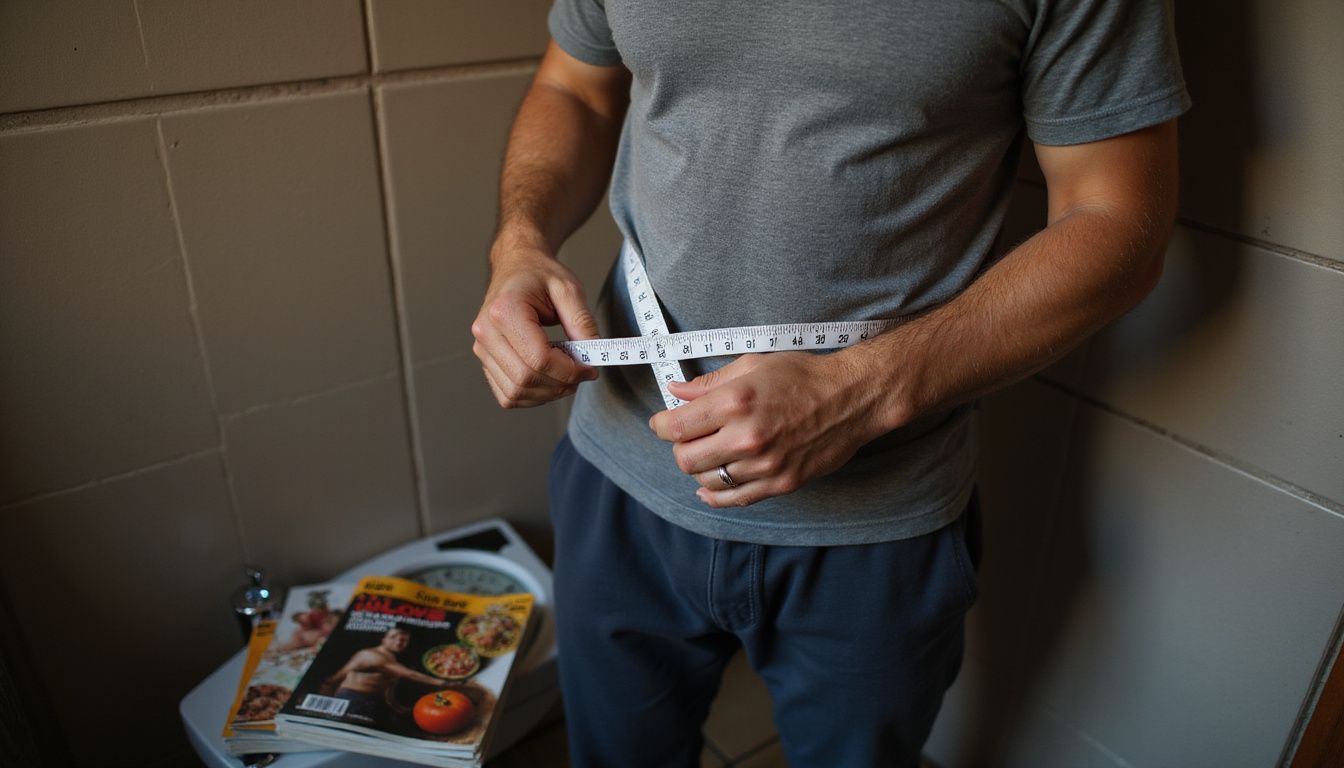
Belly fat includes two types, subcutaneous fat under the skin and visceral fat deeper in the abdomen. Visceral fat is closely linked with obesity, heart disease, and type 2 diabetes. Understanding the difference helps you target what matters most for health.
What are the differences between subcutaneous and visceral fat?
Subcutaneous fat sits just beneath your skin. You can pinch it on your belly, arms, or thighs. Visceral fat surrounds organs inside the abdomen including your liver and intestines.
Visceral fat releases hormones and inflammatory chemicals into the blood. This raises health risks more than subcutaneous fat. Doctors connect high visceral fat with greater risk of cardiovascular disease, type 2 diabetes, and certain cancers. Subcutaneous fat is less harmful and mainly stores energy.
As a dietitian once told me during my own weight loss, “Focusing on reducing visceral adipose tissue does more than slim your waistline; it may help reduce serious health conditions too.”.
You cannot see visceral fat with the naked eye, but its effects show up in blood tests and medical scans.
Why is it important to target visceral fat specifically?
Visceral fat collects around key organs like the liver and pancreas. It raises the chance of heart disease, type 2 diabetes, high blood pressure, sleep apnea, and some cancers. The American Heart Association notes that higher visceral fat is linked with heart attacks and metabolic issues. JAMA reports more visceral fat is tied to insulin resistance and fatty liver.
Inflammatory chemicals from visceral fat can damage blood vessels, raise blood sugar, and increase blood pressure. Losing this fat through healthy eating, aerobic exercise, good sleep, and fewer added sugars can protect your organs. As your waistline shrinks, you likely lower health risks.
Next, see how a calorie deficit and portion control support a practical weight loss plan created by a dietitian.
Key Principles of a One-Month Diet Plan
A one-month diet plan for belly fat uses simple, proven strategies. These principles help you create a plan for better weight management and visceral fat loss.
How do calorie deficit and portion control help reduce belly fat?
Eating fewer calories than your body burns creates a calorie deficit. Your body then uses stored fat, including visceral fat, for energy. A daily deficit of 500 to 1,000 calories often leads to 1 to 2 pounds of weight loss per week, which the CDC considers safe for most adults.
Portion control prevents overeating, even with healthy foods. Using smaller plates, measuring servings, and logging meals can cut hidden calories. I learned that trimming one slice of bread or serving a half cup less rice at dinner made a noticeable difference in my waistline.
Why are balanced macronutrients essential for fat loss?
Calories matter, but the mix of protein, carbohydrate, and fat shapes your results. Protein builds and protects muscle and increases fullness. Carbohydrates fuel daily activity. Healthy fats support hormones and absorption of vitamins.
Build plates with lean proteins like chicken, fish, eggs, or beans, complex carbs from whole grains, fruits, or vegetables, and healthy fats from olive oil, avocado, nuts, or seeds. This balance helps reduce waist circumference, supports steady energy, and limits muscle loss during weight reduction.
How does hydration affect fat loss?
Water helps your body function and may nudge metabolism higher for a short time. Drinking 500 milliliters of water can temporarily raise calorie burn. Water also helps manage appetite and keeps fiber moving through the digestive tract, which reduces bloating and helps you gauge real waist changes.
I started each meal with a glass of water during week 1. That simple habit helped me feel satisfied and kept weekly weight loss near 1 to 2 pounds.
What role does meal timing play in losing belly fat?
Eating on a schedule helps control hunger hormones and may improve insulin sensitivity, the body’s ability to manage blood sugar. Some research shows eating more of your calories earlier in the day can help weight loss. One study in Obesity found that people who ate lunch before 3 p.m. lost more weight than late eaters.
Spacing meals every three to four hours supports steady energy and fewer cravings for processed foods or sweet drinks. Planning protein around regular meal times can also reduce late-night snacking, which may worsen liver fat and increase visceral fat.
Foods to Include in Your Diet
Smart food choices make a healthy diet easier to follow. These options help you promote weight loss, support a stable calorie intake, and reduce belly fat.
Which high-fiber foods help reduce belly fat?
Beans, lentils, and peas supply soluble fiber that slows digestion, supports fullness, and can lower visceral fat. Whole grains like oats, brown rice, quinoa, and barley steady blood sugar and help you feel satisfied.
Fruits such as apples, pears, oranges, and berries are rich in fiber and low in calories. Vegetables like broccoli, carrots, spinach, and Brussels sprouts add volume to meals, so portion control feels easier. Chia seeds and flaxseeds boost fiber in yogurt or smoothies.
People who increase fiber during a one-month diet plan often see bigger drops in waist size. High-fiber eating also cuts cravings and supports consistent habits.
What are the best lean protein sources for weight loss?
Skinless chicken breast, turkey breast, and white fish like cod or tilapia provide high-quality protein with little saturated fat. Egg whites are protein rich and low in calories.
Low-fat dairy options such as Greek yogurt, cottage cheese, and skim milk add calcium and protein that help maintain muscle during a calorie deficit. Plant-focused eaters can use lentils, black beans, chickpeas, tofu, tempeh, and edamame to hit protein goals. A 3-ounce serving of salmon delivers about 22 grams of protein and omega-3 fats that may reduce inflammation tied to abdominal obesity.
Protein triggers peptide YY, a hormone that promotes fullness. Enough protein, plus portion control and regular exercise, supports sustainable weight loss of 1 to 2 pounds per week.
Which healthy fats support belly fat reduction?
After you plan your protein, include healthy fats to support hormones and satiety. Olive oil, avocados, almonds, walnuts, chia seeds, and flaxseeds supply helpful fatty acids that support metabolism and heart health.
Replacing saturated fats with these options relates to a smaller waist and better cholesterol patterns. I swapped margarine and packaged snacks for a handful of raw nuts or mashed avocado on toast. It kept me satisfied and cut processed ingredients.
Diets higher in monounsaturated fats often show lower body mass index and better glucose control. These fats can support a healthy weight and reduce strain on your arteries.
How do probiotic-rich foods aid in fat loss?
Probiotic foods contain helpful bacteria that support gut balance. Greek yogurt, kimchi, kefir, and sauerkraut may improve digestion, reduce bloating, and help your body use calories more efficiently.
People who eat more probiotic foods sometimes see lower body fat and smaller waists. They can also help tame cravings for soft drinks, bagels, and sugary snacks. Add a probiotic choice on day 1 of your plan to support your digestive system and visceral fat goals.
Foods to Avoid or Limit
Your food choices can work for or against belly fat loss. The items below tend to raise calorie intake fast and can stall progress.
Why should sugary beverages and snacks be avoided?
Regular soda and sweet drinks deliver many calories with few nutrients. One can of soda holds about 39 grams of sugar, close to 156 calories. These drinks spike blood sugar and insulin, which encourages fat storage in the belly.
High-sugar intake relates to more visceral fat and higher risk of heart disease, type 2 diabetes, and fatty liver. Candy bars, cookies, and many processed snacks have added sugars and refined carbs with little fiber. That mix leaves you hungry sooner and more likely to overeat.
After I cut sweet drinks in week 2 of a plant-forward plan, my cravings dropped in a few days. Swap sugary beverages for water or unsweetened tea to help manage calories and waist size.
What are the risks of consuming trans fats and processed foods?
Trans fats raise LDL, the “bad” cholesterol, and lower HDL, the “good” kind. This shift promotes plaque in the arteries and raises cardiovascular risk. Many processed foods also pack excess sodium, added sugars, low fiber, and poor-quality fats, which promote belly fat around organs like the liver.
A 2020 review associated higher trans fat intake with larger waist measurements compared with lower intake^1^. I saw progress after replacing packaged snacks with fresh vegetables and simple protein. Small swaps reduce these risky nutrients over time.
…
^1^: Mozaffarian D et al., “Trans fatty acids and systemic inflammation,” Am J Clin Nutr., 2004 Jun;79(6):1007-15.
How do refined carbohydrates impact belly fat?
Refined carbs like white bread, sugary cereals, and pastries cause quick rises in blood sugar. Your body releases more insulin to manage the spike. High insulin signals the body to store fat, particularly in the abdomen and liver.
People who eat more refined grains and sugars often show larger waistlines and higher metabolic risk. Replacing refined carbs with whole grains and high-fiber choices supports visceral fat loss and better energy control.
Why limit excessive sodium and alcohol intake?
Too much sodium causes water retention and can raise blood pressure. That may make your waist look larger and increases stress on the heart and kidneys. Many processed and fast foods push daily sodium above the 2,300 milligram limit.
Alcohol adds empty calories and can slow fat burning. It also weakens food decisions, which can lead to late-night snacking. Frequent drinking makes portion control harder and can add belly fat over time.
Focus on whole foods and set limits for salty items and alcohol. This change supports both heart health and waistline goals.
Sample One-Month Diet Plan
This four-week plan helps you build habits that target visceral fat. Each week adds a simple focus so changes feel manageable.
What does a gradual transition to healthier meals look like in Week 1?
Start with simple swaps. Replace sugary drinks with water or unsweetened tea to lower calories and help hydration. Add one extra serving of vegetables to lunch or dinner to raise fiber.
Choose whole grains like brown rice or whole-wheat bread instead of white versions. Prepare basic home-cooked meals, such as grilled chicken with steamed broccoli. Include lean protein, like eggs, beans, or fish, at least once daily to support muscle while dieting.
Notice how these swaps affect hunger and energy. Small changes in week 1 make week 2 easier.
How to focus on fiber and protein-rich meals in Week 2?
Build meals around fiber and protein. Use quinoa, brown rice, and oats. Add beans, lentils, or chickpeas to soups and salads. Pick lean protein such as grilled chicken, tofu, turkey, or Greek yogurt.
Aim for two servings of vegetables at lunch and dinner. The USDA suggests 25 grams of fiber per day for most women and 38 grams for most men. During my own week 2, eggs with spinach at breakfast and lentil soup at lunch cut my hunger and kept energy stable.
Use a food tracking app to check intake, especially if you follow vegetarianism or have special needs. Next comes probiotics and trimming refined carbs in week 3.
What changes should be made to add probiotics and reduce refined carbs in Week 3?
Add probiotic foods like Greek yogurt, kefir, sauerkraut, and kimchi. Pick plain yogurt to avoid added sugar. These foods support gut health, which may aid belly fat loss.
Reduce refined carbs by choosing brown rice, whole-grain bread, or quinoa in place of white bread, white rice, and pastries. Limit sugary snacks and switch soda for water or green tea. Read labels to find hidden refined sugars and flours.
How to maintain consistency and monitor progress in Week 4?
Keep your routine steady and track results closely. Log meals, snacks, and beverages each day. Weigh in weekly at the same time and measure your waist with a tape measure for a better view of visceral fat change.
Set reminders for meal times, water, and movement. Short daily walks and relaxed breathing help reduce stress and support muscle health. Check your progress with simple signals like how your clothes fit. If the pace slows, adjust the plan for the next month rather than waiting until week 5.
Breakfast Ideas for Belly Fat Reduction
Start your day with meals that help control appetite and support a leaner waist. A balanced breakfast sets a calm tone for the morning.
What are some healthy Greek yogurt breakfast options?
Top Greek yogurt with strawberries, blueberries, and a small handful of raw nuts for fiber and protein. Mix in a tablespoon of chia or flaxseeds to support digestion and fullness. A light drizzle of honey and a sprinkle of granola add texture if needed.
Layer yogurt with chopped apple, cinnamon, and walnuts for probiotics, healthy fats, and antioxidants. Serve with whole-grain toast for steady energy. I often pair yogurt with banana slices and sunflower seeds, which keeps me full until lunch.
How to make whole-grain toast with avocado and eggs for breakfast?
Whole-grain toast offers more fiber than white bread and supports gut health. Toast one or two slices. Mash a ripe avocado and spread it on the toast. Add a small pinch of salt, or skip it to reduce sodium.
Cook one or two eggs, boiled, poached, or scrambled with minimal oil. Place the eggs on the toast, then add tomato slices or greens. This plate gives complex carbs, healthy fats, and protein to support weight loss and a smaller waist.
Which smoothies with spinach, banana, and almond milk aid fat loss?
Spinach, banana, and almond milk make a low-calorie, nutrient-dense smoothie. Spinach delivers fiber and key vitamins with very few calories [1]. Bananas add natural sweetness and potassium for muscle function after exercise [2]. Unsweetened almond milk has about 30 to 40 calories per cup, which keeps the drink light.
Blend one cup spinach, half a frozen banana, and one cup unsweetened almond milk for a drink under 100 calories. Add chia or flaxseeds for healthy fats and longer-lasting fullness. Higher fiber intake is linked to less visceral fat, which supports waist goals [3]. This quick smoothie helps me hydrate and stay satisfied through the morning.
…
[1] USDA FoodData Central (2020).
[2] Harvard T.H. Chan School of Public Health—Nutrition Source (2024).
[3] Mayo Clinic Proceedings (2015): Impact of Dietary Fiber Intake on Visceral Fat Reduction
Lunch Ideas for a Flat Stomach
Midday meals can be simple, filling, and friendly to your waistline. Choose options that balance protein, fiber, and healthy fats.
How to prepare grilled chicken salad with olive oil dressing?
Grill a skinless chicken breast to an internal temperature of 165°F. Slice and place it over leafy greens such as spinach or romaine. Add cucumber, cherry tomatoes, and bell peppers for fiber and color.
Whisk one tablespoon olive oil with a teaspoon of lemon juice, plus a pinch of salt and pepper. Olive oil supports absorption of fat-soluble vitamins. This salad is high in protein and fiber, which supports belly fat reduction without excess calories.
What goes into a quinoa bowl with vegetables and lean protein?
Use cooked quinoa as the base. Add vegetables like spinach, cherry tomatoes, bell peppers, and steamed broccoli. Include grilled chicken breast, baked salmon, or tofu for lean protein.
Top with sliced avocado or a drizzle of olive oil. Sprinkle chia or pumpkin seeds for crunch. I batch-prep quinoa bowls on Sundays so lunches are ready to go. The mix of complex carbs, protein, and healthy fats keeps me full longer and supports a smaller waistline.
How to make lentil soup with whole-grain bread for lunch?
Rinse one cup lentils. In a pot, sauté onions, carrots, and celery in one tablespoon olive oil. Add minced garlic and cook one more minute. Pour in four cups low-sodium vegetable broth. Stir in lentils, one teaspoon cumin, one teaspoon dried thyme, and a bay leaf. Simmer 25 to 30 minutes until tender.
Season to taste and remove the bay leaf. Serve with a slice of whole-grain bread to boost fiber. Add a side salad or low-fat Greek yogurt for extra nutrients and probiotics. This lunch offers steady energy and can help reduce calorie intake through the afternoon.
Dinner Ideas for Weight Loss
Evening meals can be satisfying without slowing progress. Focus on lean proteins, plenty of vegetables, and smart portions.
What are easy recipes for baked salmon with steamed broccoli and quinoa?
Brush salmon with olive oil, lemon juice, garlic powder, pepper, and a pinch of salt. Bake at 400°F for 12 to 15 minutes. Steam broccoli until bright green and tender.
Rinse quinoa and cook in a 2 to 1 water to grain ratio for about 15 minutes. This plate delivers protein, fiber, and complex carbs. Quinoa provides minerals like magnesium and supplies steady energy. Protein with fiber supports fat loss and helps you meet nutrition needs with fewer calories.
How to stir-fry tofu with mixed vegetables for dinner?
Cut firm tofu into cubes and pat dry. Heat a nonstick skillet or wok over medium-high. Add one tablespoon olive oil and brown the tofu for two to three minutes per side. Remove and set aside.
Add more oil if needed, then cook chopped broccoli, carrots, bell peppers, and snap peas for four to five minutes until tender-crisp. Return tofu to the pan. Stir in low-sodium soy sauce, garlic, and ginger for one minute. Serve over brown rice for fiber and fullness.
What makes a grilled turkey burger with roasted veggies effective for weight loss?
A 4-ounce lean turkey patty has about 150 calories, 22 grams of protein, and around 6 grams of fat. Protein supports fullness and helps prevent overeating. Roasted vegetables like bell peppers, zucchini, and carrots add fiber and volume with few calories.
Use minimal oil during roasting and grilling to keep calories in check. This pairing supports a calorie deficit, reduces processed foods, and helps you target visceral fat. It fits well in a weight loss plan that prioritizes simple, whole ingredients.
Snack Options to Support Your Goals
Smart snacks curb hunger and protect your calorie budget. Choose options that are easy to prep and carry.
What are healthy raw nuts and seeds snack ideas?
Raw almonds, walnuts, and cashews provide protein and heart-friendly fats. A 1 ounce portion keeps you satisfied without blowing your plan. Pumpkin and sunflower seeds add magnesium, zinc, and fiber.
Stir chia or flaxseeds into yogurt for an omega-3 boost. Store nuts and seeds in airtight containers and buy unsalted versions to control sodium. Pre-portion servings to avoid extra calories.
How to prepare sliced veggies with hummus as a snack?
Wash and slice carrots, cucumber, bell peppers, and celery. Plate the veggies and serve with two to three tablespoons of hummus. Hummus provides protein and fiber that help you stay full between meals.
Pick low-sodium hummus to manage salt intake. This snack supports belly fat reduction by replacing sugary items with crisp vegetables and a satisfying dip.
Why are hard-boiled eggs good snack choices?
Hard-boiled eggs are portable and protein rich. One large egg has about 6 grams of protein and fewer than 80 calories. That mix supports a calorie deficit without leaving you hungry.
Eggs supply vitamin D, B vitamins, and choline, nutrients that aid energy metabolism. The healthy fats in eggs help regulate hunger hormones. I often boil a batch on Sundays for quick snacks after workouts or during busy days.
Many nutrition experts recommend lean proteins like eggs for effective belly fat diets due to strong research before June 2024.
Exercise and Physical Activity
Movement works with your eating plan to reduce belly fat. Cardio and strength training both matter for results.
Which cardio exercises help burn belly fat effectively?
High-intensity interval training, or HIIT, spikes your heart rate and burns calories quickly. Studies suggest HIIT can reduce visceral fat better than steady-state cardio. Running, cycling, and brisk walking also raise energy burn and help shrink the waist.
Aim for at least 150 minutes of moderate cardio each week. Swimming and jumping rope challenge many muscles and keep metabolism elevated. Daily walks helped me reduce belly fat and see a smaller waist within four weeks.
How does strength training support muscle building and fat loss?
Strength training builds muscle, and muscle burns more calories at rest than fat. After lifting, your body uses energy to repair tissue, which supports fat loss and better body composition.
Lifting weights at least two days per week helps reduce visceral fat while protecting metabolism during a calorie deficit. I noticed my clothes fit better at the waist once I added regular resistance sessions with dumbbells and bands.
What are simple ways to incorporate daily movement like walking?
Choose stairs over elevators. Walk short errands. Set hourly reminders to stand up and move for a few minutes. Track steps with a watch or phone and aim for 7,000 to 10,000 steps per day.
Walking after meals improves digestion and keeps energy steady. Take calls on the go. If you have a dog, use morning and evening walks for bonus activity. Small habits add up without overwhelming your schedule.
Common Mistakes to Avoid
Some habits can slow progress even when the rest of your plan looks solid. Watch for these pitfalls and correct them early.
Why is skipping meals detrimental to fat loss?
Skipping meals can lead to overeating later and makes staying in a calorie deficit harder. Hunger spikes raise cravings for sugary or high-calorie foods. Blood sugar dips can also cause fatigue or dizziness, which lowers motivation to exercise.
Eating regular, balanced meals supports steady energy and reduces urges that work against belly fat loss.
How can overeating “healthy” foods hinder progress?
Healthy foods still contain calories. Nuts, avocados, oils, and whole grains are nutritious but calorie dense. A second serving can quietly push you over your target for the day.
Large smoothies and generous oil pours add up fast. Measure portions so your waistline keeps moving in the right direction.
What happens if you neglect physical activity during dieting?
Cutting calories without moving more can cost you muscle. With less muscle, your body burns fewer calories at rest and may hold on to belly fat. Research shows combining calorie control with exercise reduces more visceral fat than diet changes alone.
When I tried diet changes without workouts, my energy dropped, and progress around my waist stalled. Regular activity protects lean tissue and supports long-term success.
Monitoring Your Progress
Tracking helps you see what works. Measure both intake and outcomes so you can adjust with confidence.
How to track meals and calories accurately?
Use a food diary app or a notebook to record everything you eat and drink. Tools like MyFitnessPal and Lose It! allow barcode scanning and portion estimates. Weigh calorie-dense foods like nuts, oils, and cheese with a kitchen scale for accuracy.
Read nutrition labels and note serving sizes. Set a daily calorie goal that fits your age and activity level. I log meals right after eating, which keeps my records honest and makes weekly reviews easier.
Why measure waist circumference regularly?
Waist circumference tracks belly fat changes better than weight alone. Extra visceral fat raises heart and diabetes risk even at a normal BMI. Weekly waist checks show progress from your one-month diet plan focused on a calorie deficit and balanced nutrition.
Health guidelines often suggest keeping waist below 40 inches for most men and 35 inches for most women. Seeing even small losses helps you stay motivated.
When and how should you adjust your diet plan based on results?
Review progress each week. If weight or waist size stalls for two weeks, trim daily calories by 100 to 200. Emphasize high-fiber foods like oats and beans, and lean proteins such as chicken or fish.
If hunger or fatigue rises, add a small snack like a hard-boiled egg or a handful of nuts. Adjust meal timing, eat more vegetables, and drink more water to manage appetite. Make slow changes so you maintain energy and protect muscle.
Track what you eat and how you feel. If cravings increase, include some healthy fats like olive oil or avocado at meals. Consistent, small changes will help reduce belly fat and visceral fat over time.
Conclusion
This one month plan helps you lose weight and reduce visceral belly fat safely. Build plates with high-fiber foods, lean proteins, and healthy fats. Drink water, limit processed foods and added sugar, and stay active with cardio and strength training.
Track meals and waist size each week so you can adjust your plan. Progress may be gradual, yet steady habits will reshape your waistline and improve health. Celebrate each small win as you move closer to your goals.
FAQs
1. What is an effective one month diet plan to reduce belly fat and target visceral fat?
A structured one month diet plan to reduce belly fat and target visceral fat includes eating more whole grains, lean proteins, and vegetables while limiting added sugars and processed foods. Studies show that reducing calorie intake by 500 to 750 calories per day can help most adults lose about one to two pounds per week.1 Regular exercise, such as brisk walking or cycling, supports fat loss and helps maintain muscle mass.
2. How does a one month diet plan help lose weight and reduce visceral fat?
A one month diet plan helps by creating a calorie deficit, which forces the body to use stored fat for energy. Research from the National Institutes of Health shows that losing five to ten percent of body weight can lower visceral fat and improve heart health.2 Consistent meal timing and portion control also help regulate hunger and prevent overeating.
3. What foods should I include and avoid in a diet plan to reduce belly fat?
Include foods high in fiber, such as oats, beans, and leafy greens. Choose lean proteins like chicken, fish, and tofu. Avoid foods with high amounts of added sugar, refined grains, and saturated fats. A table of recommended foods and foods to limit can help guide choices:
Recommended Foods | Foods to Limit
——————|—————
Whole grains | White bread
Lean proteins| Processed meats
Vegetables | Sugary drinks
Fruits | Fried foods
4. Can I see results in one month with a diet plan targeting belly fat?
Many people notice some reduction in belly size and weight within four weeks if they follow the plan closely. A personal example, after following a similar plan, I lost six pounds and noticed my clothes fit better. Results vary based on age, activity level, and starting weight, but research supports that even modest weight loss can reduce visceral fat and improve overall health.3
Summary: A focused one month diet plan, supported by scientific evidence, can help reduce belly and visceral fat through calorie control, healthy food choices, and regular activity. Consistency and commitment are key for visible and lasting results.
References:

